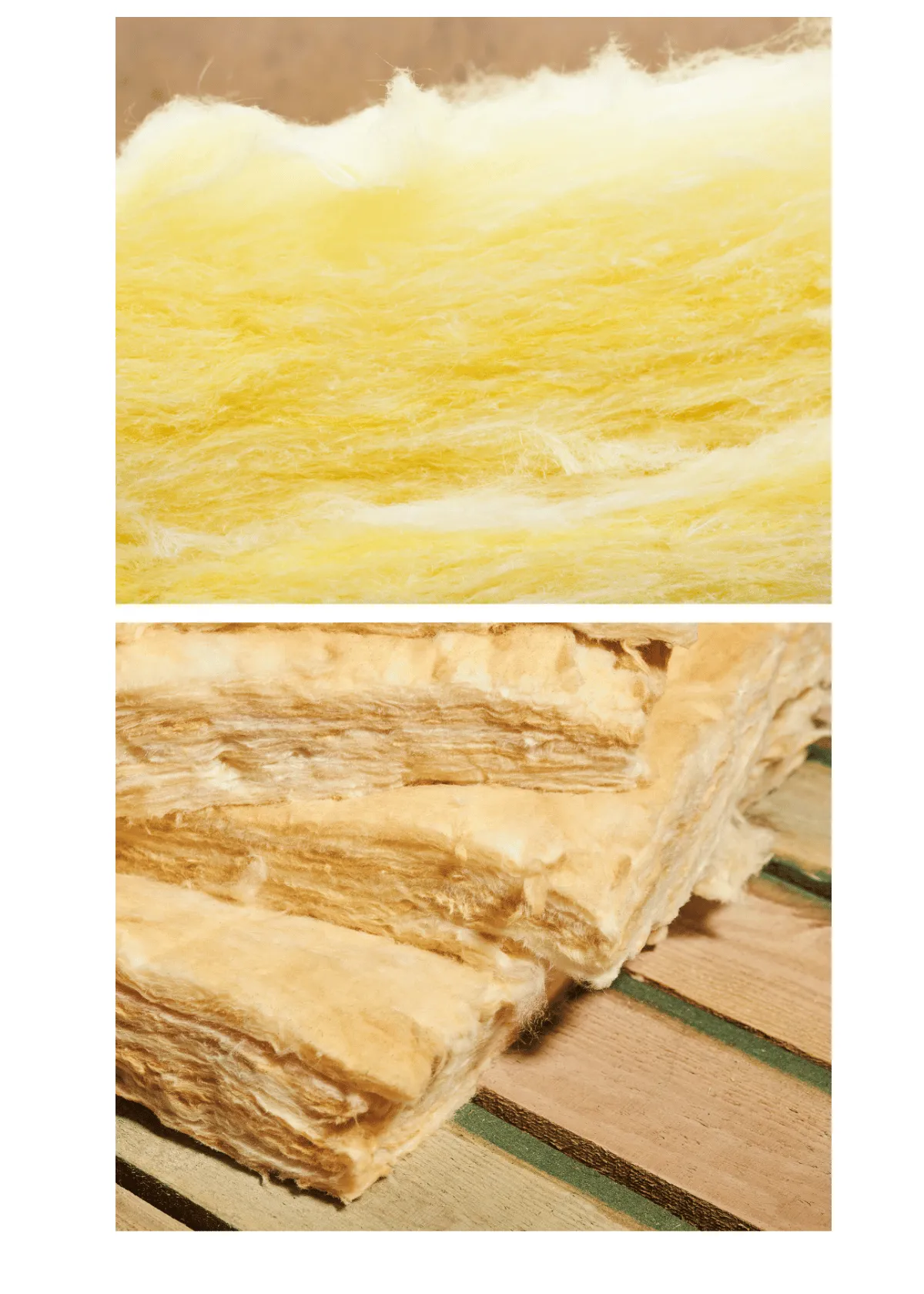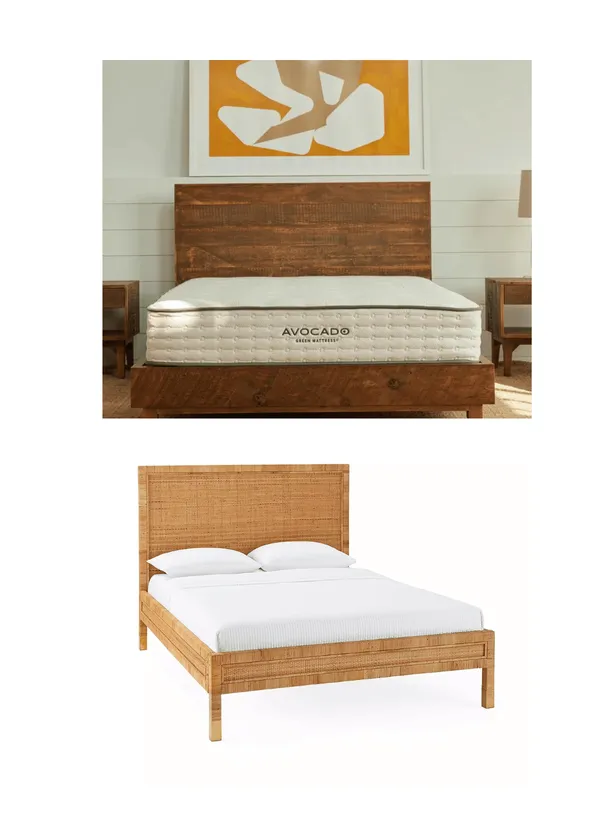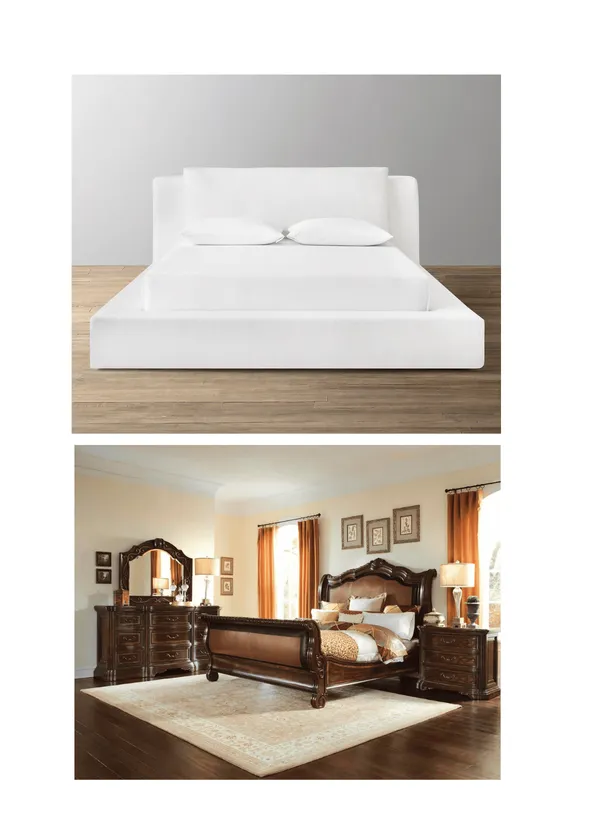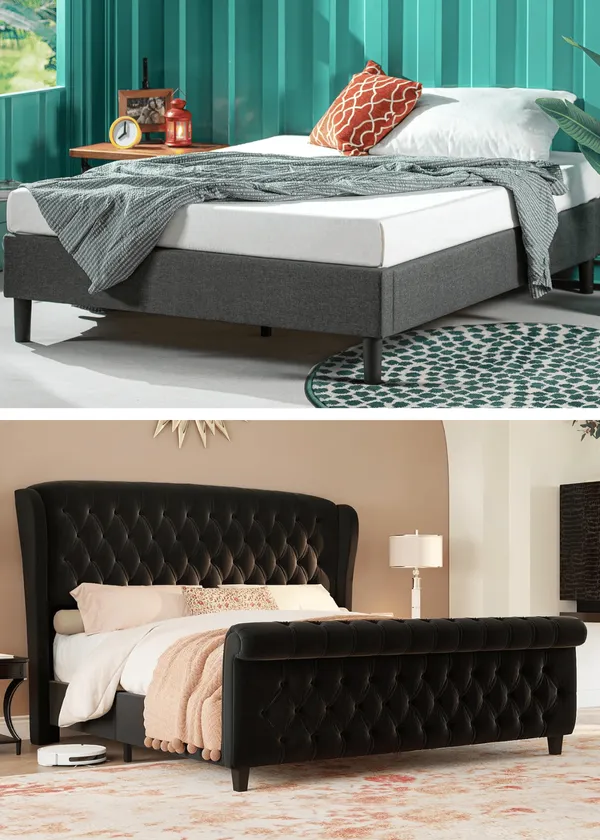(Last Update: 05/30/2024)
Imagine waking up to find your skin itchy, your eyes watering, and the air in your bedroom filled with tiny irritants.
You pull off the sheets and discover that the culprit is your mattress—specifically, the fiberglass used for fire resistance. Fiberglass is a common fire retardant material due to its ability to resist high temperatures, which is why it's used in mattresses.
This isn't just an inconvenience; it's a potential health hazard.
Welcome to the world of fiberglass mattresses! But are they truly safe for you and your family?
In this post, I will explore fiberglass, its common use in mattresses, and the associated health threats and legal claims.
Stay with us to make an informed decision about your sleep environment.

Fiberglass material: Health concerns have sparked debate about its use in mattresses.
(Credit: Canva)
What Is Fiberglass?
Definition: Fiberglass, scientifically known as glass-reinforced plastic (GRP), is a composite material of fine glass fibers woven into a fabric and set using resin.
Fiberglass beds often contain fiberglass for fire protection. The fiberglass inside serves as a fire retardant layer.
While effective for fire protection, fiberglass poses some health challenges. Consumers should read tags carefully to understand the materials used.
Common Uses:
Fiberglass is ubiquitous in many products and industries—from automotive and aerospace to construction and electronics.
Its high tensile strength, low weight, and weather-resistant properties make it a popular choice for boat hulls, car bodies, roofing, and insulation, among other materials. (Source: U.S. Environmental Protection Agency, "Fiberglass: A Versatile Material").
There are several hazardous flame retardant chemicals that have been used in beds, including:
- Polybrominated biphenyls (PBBs): PBBs are a group of chemicals used as flame retardants in various products, including mattresses, until they were banned in the United States in 1979.
- Polybrominated diphenyl ethers (PBDEs): PBDEs are another group of chemicals used as fire retardants in various products, including mattresses.
- Organophosphate flame retardants (OPFRs): OPFRs are a newer class of fire retardants often used to replace PBBs and PBDEs.
- Antimony trioxide: Antimony trioxide is a flame retardant used in some mattresses.

Fiberglass is lightweight yet durable for roof safety.
(Credit: Canva)
Fiberglass in Mattresses:
Using fiberglass in mattresses aims to meet fire-retardant standards set by regulatory bodies. A long-lasting insulating material batting layer is often used beneath the mattress cover as a fire barrier.
Glass fiber plastic (GFRP) is a composite material made of glass fibers embedded in a polymer resin. The glass fibers provide strength and stiffness, while the resin holds the fibers together.
However, this use has sparked debates and concerns regarding health and safety, as the fibers can potentially become airborne if the outer mattress cover is translucent material or the outer cover itself is removed or damaged (Source: Consumer Product Safety Commission, "Standard for the Flammability of Mattresses and Mattress Pads").
Why Is the Fiberglass Mattress Popular?
Which mattresses contain Fiberglass? For several reasons, these beds have gained traction in the market, but the cost is often the most compelling.
These mattresses, like memory foam or latex mattresses, are generally more affordable than their counterparts.
Fiberglass in a mattress can catch fire less easily, but concerns about health issues like lung inflammation make it a controversial choice.

Fiberglass offers superior insulation in factories.
(Credit: Canva)
The low production cost of fiberglass as a material translates to savings for the consumer, making it an attractive option for budget-conscious shoppers.
In addition to cost, the flame-retardant properties of fiberglass are also a selling point for many mattresses.
Regulatory standards require mattresses to be flame-retardant, and the fiberglass layers are an effective fire barrier. This fulfills legal requirements and gives consumers an added sense of safety.
Moreover, fiberglass beds are usually lightweight and easy to handle, adding to their convenience factor. The material's durability also means these mattresses can last considerably when properly maintained.
GREENGUARD Gold certification and fiberglass mattress: what to look for?
When evaluating mattresses, understanding the implications of GREENGUARD Gold certification can guide you toward healthier sleep options.
While GREENGUARD Gold ensures low chemical emissions, it doesn't address physical materials like fiberglass.
Always verify if a GREENGUARD Gold-certified mattress contains fiberglass to ensure comprehensive safety and comfort.
Health Risks and Concerns
Health Hazards Associated with Fiberglass Exposure
Fiberglass exposure poses several health threats, primarily through inhalation or skin contact with fiberglass fibers.
Studies have shown that these fibers can cause respiratory problems and skin inflammation.
When airborne, these fibers can be inhaled, leading to respiratory tract issues, including persistent coughing and difficulty breathing (Source: U.S. Centers for Disease Control and Prevention, "Health Effects of Exposure to Fiberglass").
- Respiratory Problems: Inhaling fiberglass fragments can lead to lung irritation, causing symptoms similar to asthma (Source: American Lung Association, "The Impact of Fiberglass on Lung Health").
- Skin inflammation: Physical contact with fiberglass can cause itchiness and rashes, requiring immediate washing and sometimes medical attention (Source: American Academy of Dermatology, "Contact Dermatitis and Fiberglass").
Eye Irritation: Fiberglass particles can also cause eye irritation, necessitating immediate rinsing and medical treatment in severe cases
Specific Health Concerns
When it comes to fiberglass beds, the health concerns are even more immediate:
Allergic Reactions: The microscopic fiberglass particles can embed themselves in bedding and clothing, triggering allergic reactions in some individuals (Source: Journal of Allergy and Clinical Immunology, "Fiberglass and Allergies").
Pregnancy Risks: Pregnant women are advised to avoid exposure to glass-plastic (GRP) as it can potentially lead to complications (Source: World Health Organization, "Maternal Health and Environmental Risks").
Pet Health: Fiberglass dust exposure can also affect pets, particularly smaller animals with sensitive respiratory systems (Source: Journal of Veterinary Science, "Impact of Fiberglass on Pet Health”).
Dangers of Fiberglass Exposure
Short-term and Long-term Dangers
Fiberglass exposure poses both immediate and long-term health threats. In the short term, exposure can lead to:
Skin Irritations from Fiberglass mattress covers:
- Contact with glass plastic (GRP) fibers can cause immediate itchiness, rashes, and skin inflammation (Source: American Academy of Dermatology, "Contact Dermatitis and Fiberglass").
Respiratory Issues:
- Inhalation of fiberglass fragments can lead to respiratory distress, including coughing and difficulty breathing (Source: American Lung Association, "The Impact of Fiberglass on Lung Health").
Long-term exposure elevates these risks, potentially leading to chronic respiratory issues and skin conditions:
Asthma and Chronic Respiratory Issues:
- Prolonged inhalation of fiberglass can exacerbate existing respiratory conditions and lead to long-term problems like asthma (Source: Journal of Occupational Medicine and Toxicology, "Long-term Exposure to Fiberglass and Respiratory Health").
Persistent Skin Conditions: Chronic skin contact can result in lingering dermatological issues, including eczema and dermatitis (Source: Dermatology Journal, "Long-term Skin Conditions and Fiberglass").
Potential Impact on Children and Pets
The California Department of Health has expressed concerns over these health problems, especially concerning children.
Man-made mineral fiber, like fiberglass, is produced from materials such as silica sand and soda ash, which are generally not harmful but can become problematic when inhaled or come into contact with skin.
Children: Due to their developing immune and respiratory systems, children are particularly vulnerable to adverse effects (Source: Pediatrics Journal, "Children's Health and Environmental Toxins").
Pets: Small animals with sensitive respiratory systems can also be significantly impacted, leading to similar respiratory and skin conditions (Source: Journal of Veterinary Science, "Impact of Fiberglass on Pet Health").
Understanding these dangers is essential for protecting human family members' and pets' health and well-being.
The Pros and the Cons of the Fiberglass Beds
Fiberglass beds offer several pros and cons that consumers should be aware of. On the positive side, the fiberglass inner cover is an effective fire retardant, providing significant resistance to catching fire.
Many mattress makers prefer using fiberglass to meet flammability standards, as it is less expensive than natural flame-retardant materials.
This makes such mattresses safe from open flame fire resistance and more affordable for consumers.
However, the cons are significant. Fiberglass in mattresses can hurt health. When the inner covers are damaged, airborne fiberglass particles can escape and become embedded in upholstery, clothing, and HVAC systems.
This can lead to various health issues, including skin irritation and pulmonary fibrosis.
Furthermore, toddlers are more vulnerable to these harmful materials, making a fiberglass mattress potentially risky.
Mattress Contains Fiberglass: Manufacturers' Labels
Yet, the heat-resistant properties of fiberglass make it a commonly utilized flame retardant agent.
Manufacturers prefer fiberglass over chemicals or heavy metals, which can also lead to health issues. The mattress manufacturer usually specifies how much fiberglass is contained on the tag.
Determining whether your mattress contains glass-reinforcing plastic (GRP) would be best. Unfortunately, not all mattress manufacturers make this information readily apparent. However, there are some key indicators to look for:
Product Labels:
Check the mattress label for words like "glass fiber" or "fiberglass." These labels are usually on a tag sewn into the mattress or packaging.
Material Lists:
If possible, please look over the materials used in the mattress. Many reputable companies will disclose this information on their websites or product manuals.
Fire-Resistant Tags and Fire Retardants:
Mattresses containing fiberglass often have tags indicating they meet fire-resistant standards, which is often an indirect clue about the presence of fiberglass.
Regulations:
According to the Federal Trade Commission, beds that contain glass-reinforced plastic (GRP) must indicate so on their tags.
However, the text can be small and easily overlooked (Source: Federal Trade Commission, "Mattress Labeling Rules").
Despite its functional benefits, consuming fiberglass fragments can cause lung problems and irritate human skin.
Additionally, if the protective layer inside the mattress breaks, the material may spread to other areas, such as upholstered furniture or even an HVAC system.
As more information becomes available, we will likely see a shift in the materials used for flame resistance in mattresses. Before purchasing, it's crucial to understand what each mattress is made of.
Fiberglass-Free Mattresses Alternatives

Saatva Classic is free from fiberglass.
(Credit: Saatva)
In recent years, other mattress companies have started offering organic mattresses without fiberglass, substituting chemical fire retardants with natural materials like wool.
Many consumers are concerned about fiberglass in mattresses. Mattresses sold today often contain a layer of fiberglass inside as a cheap flame retardant.
This layer acts as a fire-resistant barrier underneath the mattress foam. Alternatives like wool or other fire retardant agents are being considered to replace fibrous glass in future products.
Plush beds and mattresses made from organic material offer a safer alternative for those who want to protect their loved ones from harmful or combustible materials while enjoying a comfortable sleep experience.
Thus, it's worth considering mattresses that don't contain highly flammable or harmful chemicals in the first place.
Here are some recommendations:
Recommendations for Mattresses That Do Not Contain Fiberglass
- Organic Latex Mattresses: These are biodegradable and made from natural rubber. They offer excellent support and comfort without any synthetic fibers.
- Memory Foam Mattresses: Opt for high-quality, CertiPUR-US certified memory foam mattresses free from harmful chemicals and fibers.
- Innerspring Mattresses with Organic Cotton: Traditional coil mattresses covered with organic cotton layers can be a good alternative, providing both support and breathability.
- Hybrid Mattresses: Combining the benefits of foam and springs, hybrid beds offer a good compromise and are often non-fiberglass
- Natural Fiber Mattresses: Made from glass wool and cotton materials, these beds are comfortable and eco-friendly.

Nolah Original is fiberglass-free and eliminates the risk of airborne irritants.
(credit: Nolah)
Benefits of Choosing Fiberglass-Free Mattresses
While many beds have this feature, not all mattresses do. Organic mattresses, for instance, may use other methods for fire protection.
Some mattress companies avoid glass-reinforced plastic (GRP), particularly because of potential health problems like lung disease and skin irritation.

Puffy Lux Hybrid Reduces the potential for skin irritation and is fiberglass-free.
(Credit: Puffy)
Healthier Indoor Air Quality:
- Mattresses free from fiberglass don't release harmful particles into the air, contributing to a healthier indoor environment.
Reduced Allergenic Risks:
- Longevity: Many fiberglass-free mattresses are made from durable materials that offer a longer lifespan than traditional fiberglass-based mattresses.
- You're less likely to experience allergic reactions, skin irritations, or respiratory issues.
Ease of Maintenance:
- You can often remove and wash the covers of fibrous glass-exempt beds without worrying about exposing yourself to harmful fibers.
Environmental Benefits:
- Natural and organic materials are often more eco-friendly, contributing less to pollution and waste.
Using recycled glass and opting for fiberglass-exempt alternatives, you invest in your family's long-term health and comfort and contribute to a more sustainable future.
How to Handle Fiberglass in a Mattress Safely
Awareness is key. If a company sells mattresses with fibrous glass, it should be transparent about the risks.
Four mattresses recently recalled contained fiberglass that was not properly sealed, leading to heightened consumer exposure.
Tips for Minimizing Risks
Awareness is key when it comes to fiberglass in mattresses. Full transparency about the associated risks is essential if a company sells mattresses that contain this material. Many memory foam mattresses sold with fiberglass act as a fire retardant, but they can present health challenges if not properly managed. Four recently recalled mattresses had fiberglass that was not adequately sealed, leading to increased consumer risks.
Consumers should pay attention to a few key details to use a fiberglass mattress properly.
First, never remove the outer shell or inner cover, as this can release harmful fiberglass shards into the air. If extra comfort is desired, please add a mattress topper that does not contain fiberglass.
Keep the Mattress Cover Intact:
It's crucial to keep the outer cover of any memory foam mattresses sealed. The inner mattress cover often contains fiberglass, designed to act as a fire retardant. If this cover is damaged or unzipped, microscopic fiberglass particles could be released into the air. In case of any damage, opt for fiberglass-free mattress covers as replacements to minimize risk.
Use Additional Protective Layers:
To add another level of safety, use an extra mattress protector or bedding layer. This is a barrier between you and the foam mattresses, whether they contain fiberglass or other chemical flame retardants. Specialized protectors made of natural materials can also reduce exposure to flame-retardant chemicals in the mattress.
If you have a mattress with fiberglass, cleaning it is a delicate process. Use a vacuum with a HEPA filter to suck up any stray particles without releasing them into the air. Traditional vacuums can spread these particles, so a HEPA filter is crucial.
Air Quality:
Maintaining ventilation in the room is necessary, especially when mattresses incorporate fiberglass for its fire-retardant properties. Although air purifiers can help remove small particles, they are not a substitute for a well-ventilated room and proper mattress handling.
Handle with Care:
If the mattress needs to be moved, please be cautious. Dislodging the fiberglass layer can make fiberglass dangerous to your health. Always wear gloves and a protective mask to minimize the risk of inhaling or contacting these particles.
When you dispose of your mattress, consult professionals who can safely handle glass-reinforced plastic (GRP) or other fire-retardant materials. Specialized disposal methods are required to ensure that the fiberglass does not pose an environmental hazard.
Consider Fiberglass-Free Options:
While polyurethane foam is used in memory foam mattresses, it's also possible to find a fiberglass-free mattress that uses alternative fire retardants or natural materials for fire resistance. This can be an ideal solution for those looking to avoid potential health risks while still benefiting from the comfort of a memory foam mattress.
Check the Tag:
Lastly, please always look over the mattress tag. This label will tell you what materials, including fire retardants, are used in your mattress. If it contains fiberglass, you'll know to take the appropriate precautions.
Could you check mattress labels regularly and make sure all covers, especially the fiberglass barrier, are intact? Air purifiers and air conditioners can help minimize the risks but are not substitutes for proper care.
CONCLUSION and Final Thoughts
Choosing the right mattress is more than just a matter of comfort; it's a matter of health and safety.
While fiberglass used in mattresses may be cost-effective, they pose potential health risks, from minor irritations to serious respiratory issues.
There are safer, fiberglass-free alternatives that offer comfort and peace of mind.
If you already own a fiberglass mattress, I recommend rigorously following safety guidelines to minimize risks.
Your choice of a mattress shouldn't compromise your well-being.
Invest in a fiberglass-free option for a healthier, better night's sleep.
FAQs about Fiberglass Mattresses
Is it OK to sleep on a mattress with fiberglass?
While sleeping on a fiberglass mattress is generally not recommended due to potential health problems and risks, such as skin inflammation and respiratory issues, some people use them without immediate adverse health effects or problems.
However, proper handling and preventive measures are crucial to minimize exposure and related health risks.
Is it OK to buy a mattress with fiberglass?
Although purchasing a mattress with glass fiber may be budget-friendly, it can cause health problems, such as respiratory issues and skin inflammation.
If you opt for one, following safety guidelines to minimize risks is crucial, although non-fiberglass alternatives are generally safer and recommended.
How do I know if my mattress has fiberglass?
To determine if your used mattress covers or contains glass wool, check the product label or tags for terms like "fiberglass."
You can also consult the specific mattress manufacturer's website or product manual for a materials list. Some mattresses indicate fiberglass use to meet fire-resistance standards.
What to do if you have fiberglass in your bed?
If you discover, take immediate steps to minimize health risks. Keep the mattress cover intact, use additional protective layers, and clean using a HEPA filter vacuum.
Please ensure you have good room ventilation and consider professional disposal or replacement with a non-fiberglass alternative.
Do traditional mattresses have fiberglass?
Traditional innerspring mattresses typically do not contain glass plastic (GRP); they often use other materials like wool or cotton for fire resistance.
However, some modern memory foam and hybrid mattresses include fibrous glass to meet fire safety standards. Please always check labels and product descriptions to make sure.
References:
Federal Trade Commission, "Mattress Labeling Rules." (1973).
Rebecca M. Smith and Jessica L. Weese, ”Fiberglass Exposure in Cats and Dogs: A Review of the Literature.” Journal Veterinary Dermatology. 2019.







